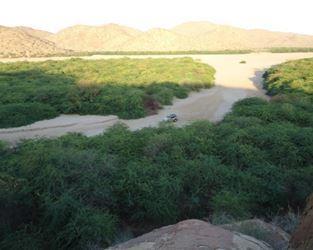SWALIM Maps Prosopis invaded areas in Somaliland
According to a study carried out by Candlelight in 2006, Prosopis was first introduced in Somalia in the early 1950 in the area west of Berbera by a British forester to combat desertification, dust storms and sand dune movement. Later, in the 1970s and 1980s, it was introduced in several areas of Somaliland to reduce environment degradation in the area. The inhabitants were destroying native trees for fuelwood and construction material. It was felt that Prosopis could growing fast compared to the slow growing native trees and therefore was a good substitute. Initially, Prosopis was confined in small areas around the refugee camps, but later spread to many parts of the country especially in the central part of Waqooyi Galbeed and Awdal Regions, mostly along waterways originating from Golis Mountain but also in creeks, agricultural farms, wetlands, coastal area along the Gulf of Aden from Lughaya to Berbera, as well as in Burco district. It is interesting to note that are no Prosopis plants in the higher altitude parts in Sheikh and Ceerigaabo.
 FAO SWALIM has been mapping and studying the spread of Prosopis in Somalia. More recently, a survey was carried in Januray 2017 together with the Somaliland Ministry of Environment and Rural Development to map out the extent of the spread of Proposis in Somaliland. Five areas of interest were selected covering the main landform units of Somaliland that include flat lying areas, plateaus, hills, mountain ranges and coastal areas. The climate of these landscapes vary from desert (annual rainfall of 100mm and temperature of 28-35 oC) in the coastal areas to semi humid (annual rainfall of 500 - 600 mm annual rainfall and temperature of 20-22 °C) in the mountain ranges.
FAO SWALIM has been mapping and studying the spread of Prosopis in Somalia. More recently, a survey was carried in Januray 2017 together with the Somaliland Ministry of Environment and Rural Development to map out the extent of the spread of Proposis in Somaliland. Five areas of interest were selected covering the main landform units of Somaliland that include flat lying areas, plateaus, hills, mountain ranges and coastal areas. The climate of these landscapes vary from desert (annual rainfall of 100mm and temperature of 28-35 oC) in the coastal areas to semi humid (annual rainfall of 500 - 600 mm annual rainfall and temperature of 20-22 °C) in the mountain ranges.
The survey observed that despite the extremely dry condition; Prosopis plants were exceptionally green and resistant to drought and were often flowering and with pods in most of the areas. Prosopis was found growing as trees or shrubs and also forms pure stand of forest thickets in the invaded rangelands and cropland. It was also scattered as shrubs in stony or gravelly surfaces inter growing with cactus. In the wetter alluvial deposits flanking the watercourses in the northern escarpment of the Golis Mountain, it was found to form very dense impenetrable thickets.
The survey observed that despite the extremely dry condition; Prosopis plants were exceptionally green and resistant to drought and were often flowering and with pods in most of the areas. Prosopis was found growing as trees or shrubs and also forms pure stand of forest thickets in the invaded rangelands and cropland. It was also scattered as shrubs in stony or gravelly surfaces inter growing with cactus. In the wetter alluvial deposits flanking the watercourses in the northern escarpment of the Golis Mountain, it was found to form very dense impenetrable thickets.
It was observed that Prosopis had a strong ability to thrive in all environments, despite the condition of soils and moisture. The survey learnt that Prosopis spreads rapidly in all directions, particularly in wetlands and along the watercourses and in the boundaries of the farms. The ecology of this region has changed with the spread of Prosopis, locally known as “Garanwaa”.
Interviews with local pastoralists and agro-pastoralists confirmed some benefits from Prosopis, particularly in drought periods. These include:
- Fuelwood and charcoal production for family use and for sale
- Livestock feed (pods)
- Shade
- Building posts, poles and sticks
- Fence for farm and animal enclosures
- Windbreak to reduce dust storm
- Reduce desertification and sand dunes stabilization
On the other hand, many negative impacts were voiced, including:
- Invasion of communal pasture lands and crop fields and reduction of cropping areas and grazing ground as land with palatable indigenous grasses, tree and shrub fodder is taken over by Prosopis.
- Livestock disease for livestock exclusively feeding on Prosopis pods for extended periods. The disease include reduced appetite and weight loss, weakness, teeth decaying, diarrhea, fever, paralysis and death.
- Reduced animal productivity in terms of milk and meat.
- Injuries to people and livestock caused by sharp and poisonous Prosopis thorns.
- Reduction in land accessibility by human and animal in invaded areas by blocking of roads and water points.
- Water scarcity due to lowering of the water table in shallow wells, as well as deterioration of the quality of water.
- Livestock attack by predators such as hyenas and jackal hiding in Prosopis invaded areas.
It is clear that the rapid spread of Prosopis in the rangelands and cropped areas of Somaliland is harming the livelihood of the communities in a significant way. The local people however do not have the knowledge required to control the spread of Prosopis.
There is a need to acquire skills and technologies needed to control the tree including making use of it. Communities have been mobilized several times by different NGOs to clear Prosopis thickets by uprooting seedlings, cutting and burning trees and burning the wood for charcoal production. However, the people are desperate as Prosopis regenerates easily and rapidly. The study therefore suggests that a more strategic approach for controlling Prosopis is required.
Running Sneakers Store | Nike Dunk Low SP University Red - Grailify


